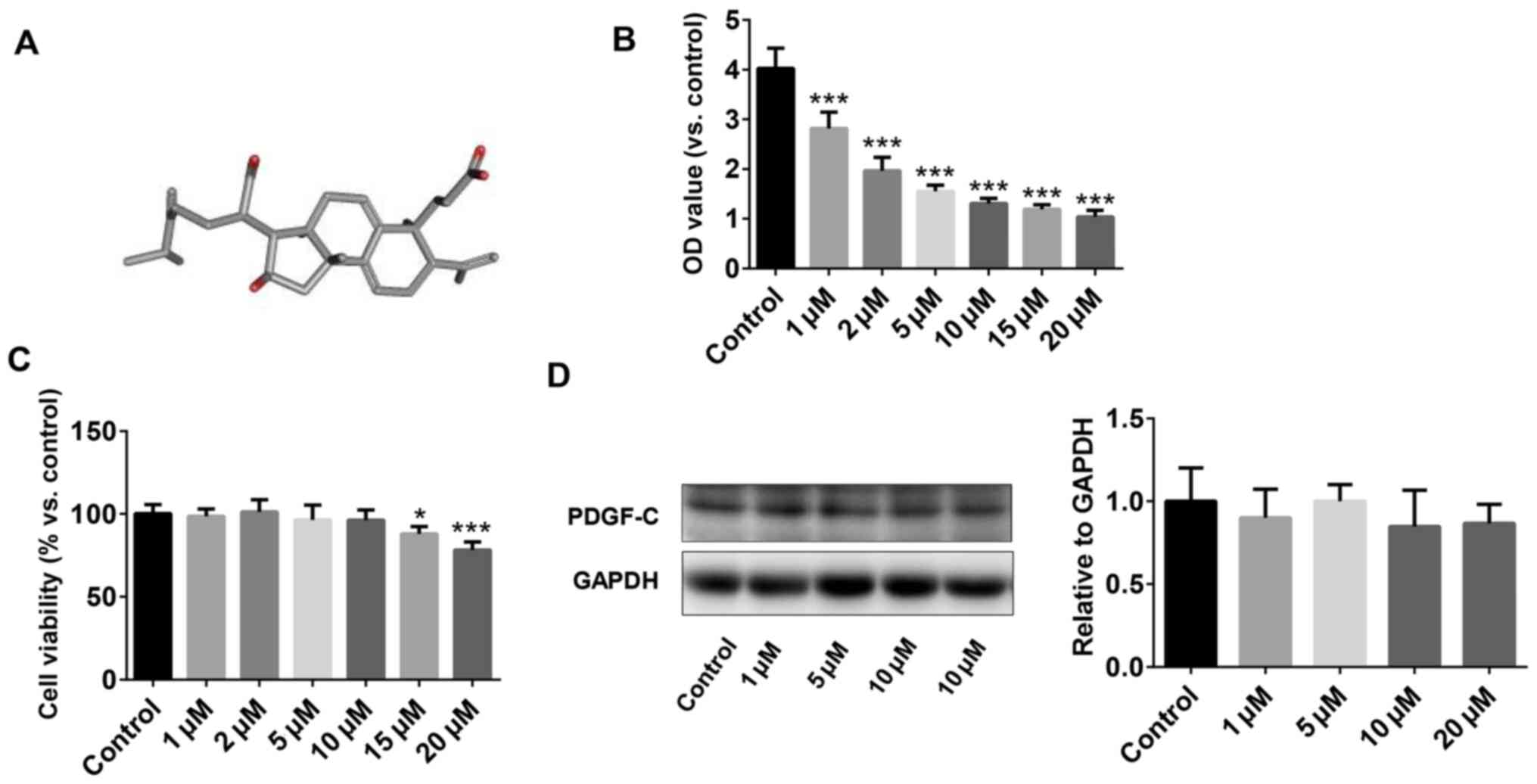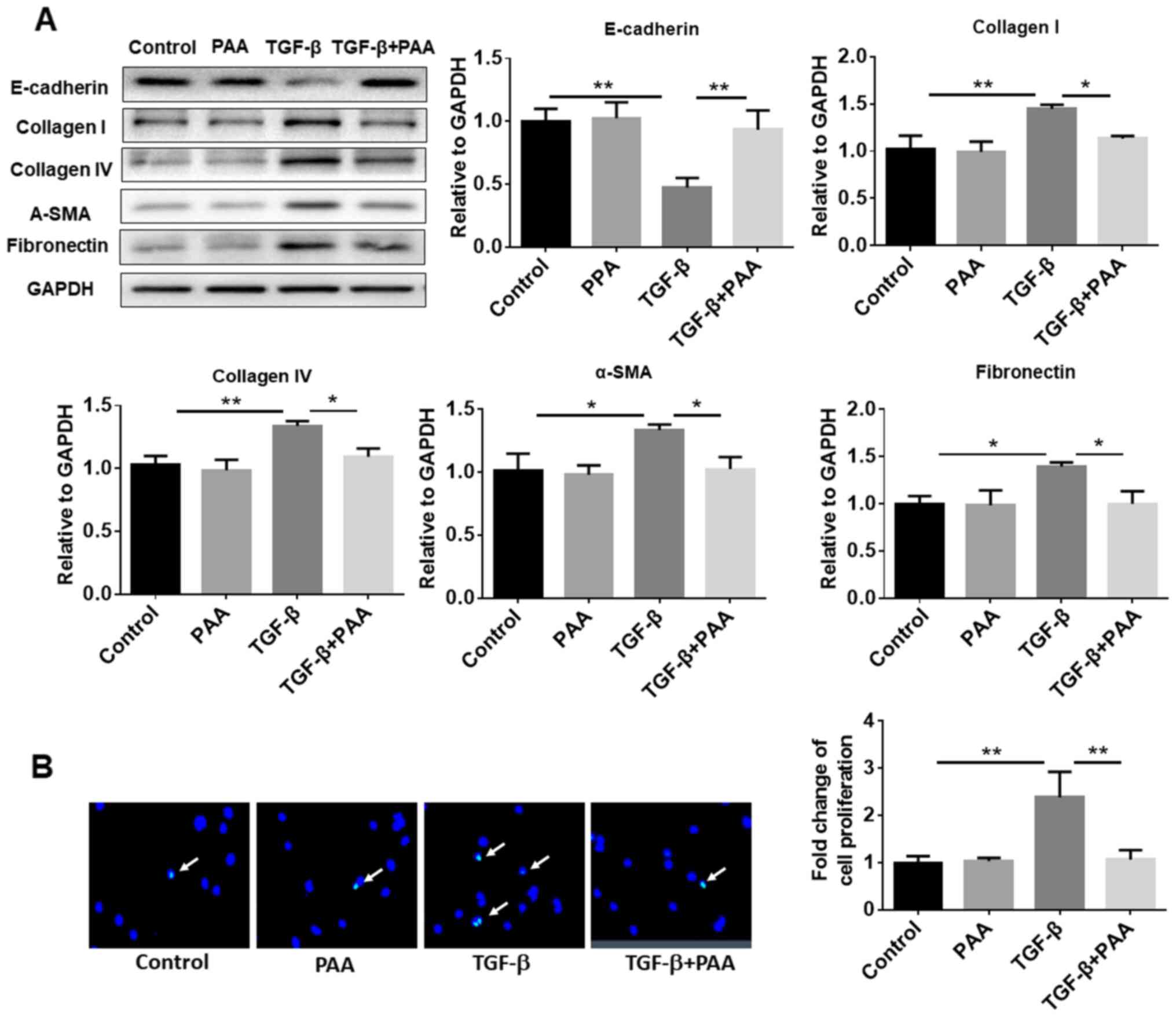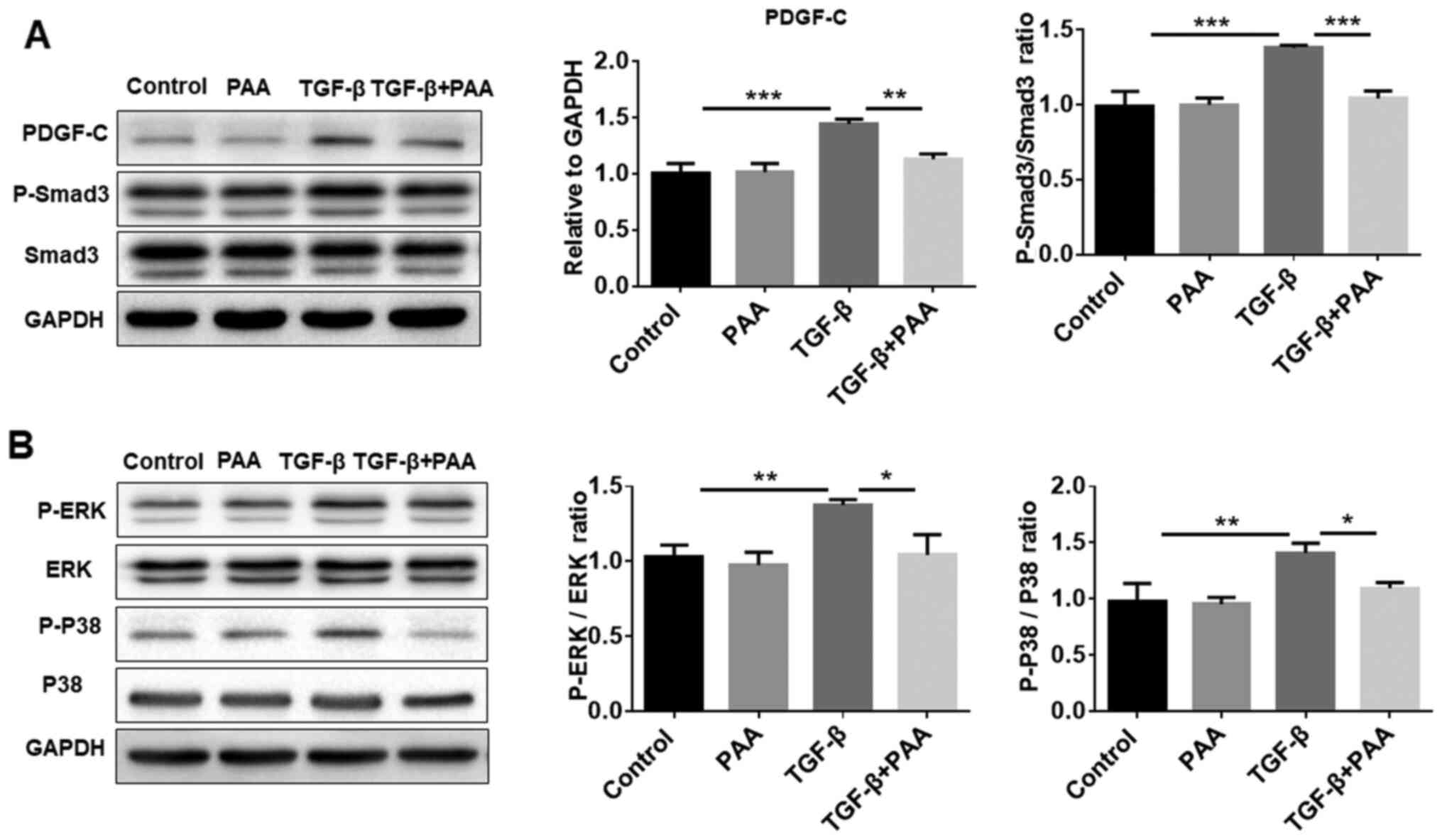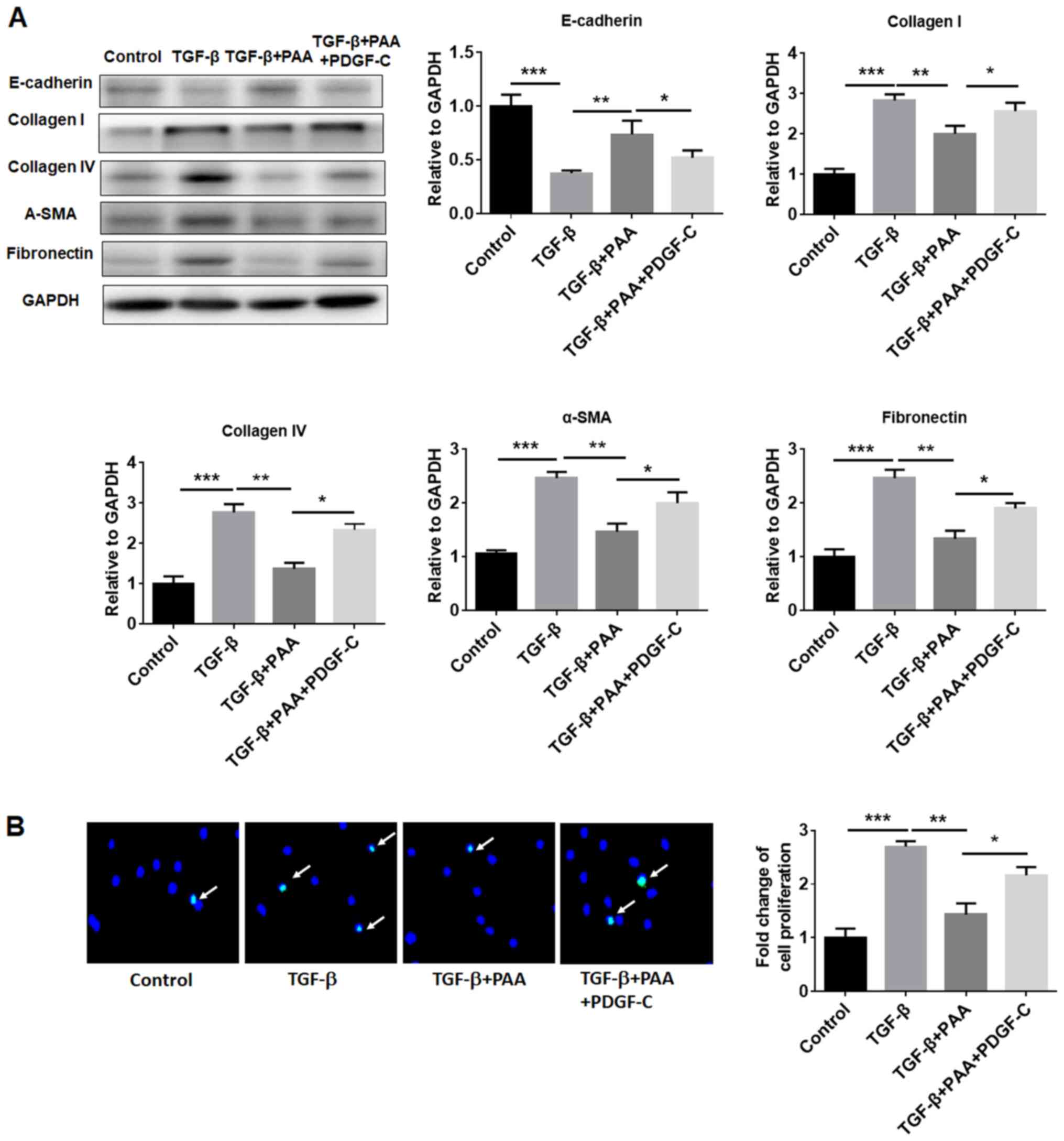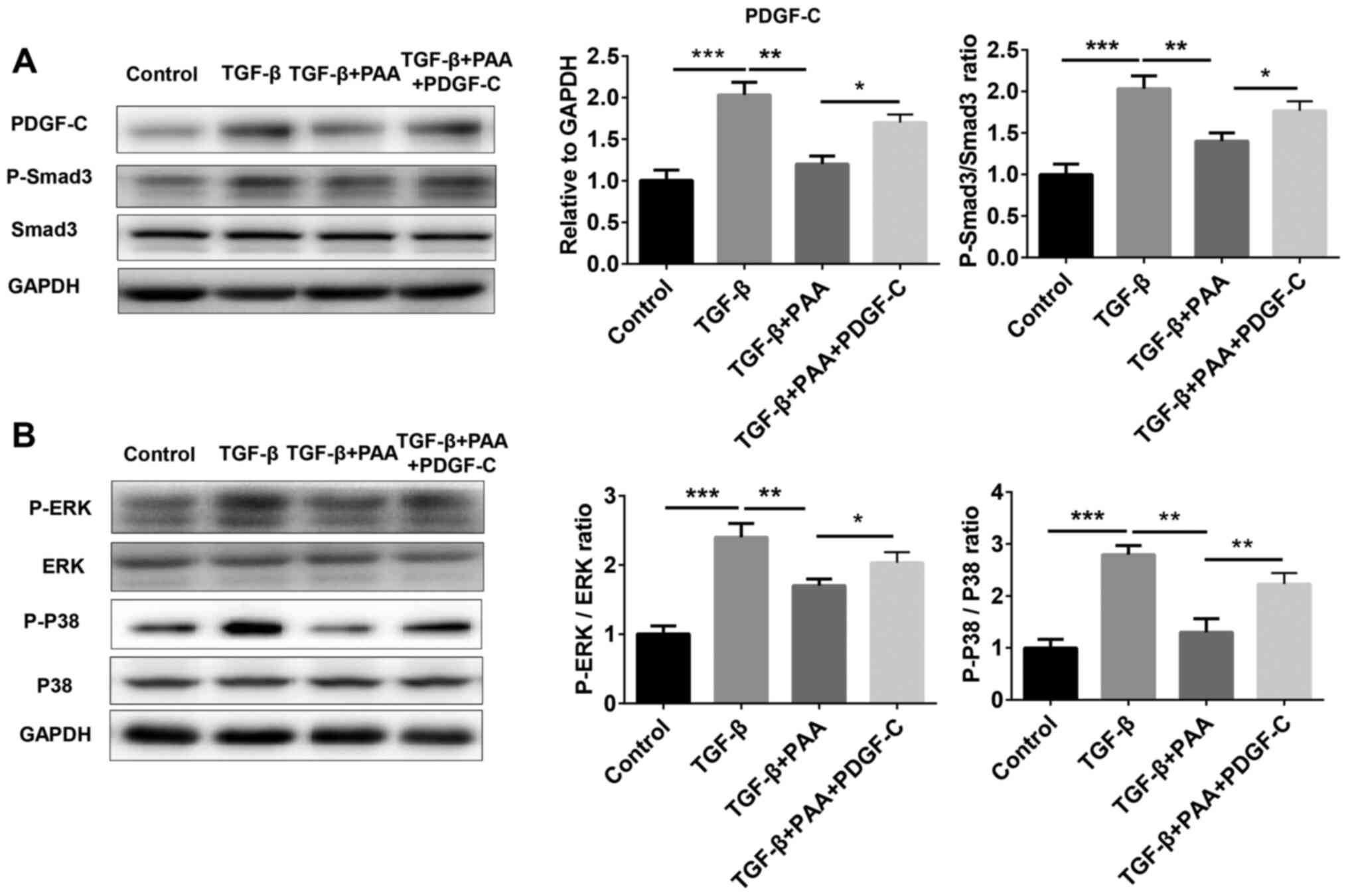|
1
|
Shiber S, Eliakim-Raz N and Yair M:
Retroperitoneal fibrosis: Case series of five patients and review
of the literature. Rev Bras Reumatol Engl Ed. 56:101–104.
2016.PubMed/NCBI View Article : Google Scholar
|
|
2
|
Zhou D and Liu Y: Renal fibrosis in 2015:
Understanding the mechanisms of kidney fibrosis. Nat Rev Nephrol.
12:68–70. 2016.PubMed/NCBI View Article : Google Scholar
|
|
3
|
Hu C, Sun L, Xiao L, Han Y, Fu X, Xiong X,
Xu X, Liu Y, Yang S, Liu F and Kanwar YS: Insights into the
mechanisms involved in the expression and regulation of
extracellular matrix proteins in diabetic nephropathy. Curr Med
Chem. 22:2858–2870. 2015.PubMed/NCBI View Article : Google Scholar
|
|
4
|
Wang J, Yang Q, Nie Y, Guo H, Zhang F,
Zhou X and Yin X: Tetrahydrobiopterin contributes to the
proliferation of mesangial cells and accumulation of extracellular
matrix in early-stage diabetic nephropathy. J Pharm Pharmacol.
69:182–190. 2017.PubMed/NCBI View Article : Google Scholar
|
|
5
|
Klinkhammer BM, Goldschmeding R, Floege J
and Boor P: Treatment of renal fibrosis-turning challenges into
opportunities. Adv Chronic Kidney Dis. 24:117–129. 2017.PubMed/NCBI View Article : Google Scholar
|
|
6
|
Sandner P and Stasch JP: Anti-fibrotic
effects of soluble guanylate cyclase stimulators and activators: A
review of the preclinical evidence. Respir Med. 122 (Suppl
1):S1–S9. 2017.PubMed/NCBI View Article : Google Scholar
|
|
7
|
Wang Y, Cai J, Tang C and Dong Z:
Mitophagy in acute kidney injury and kidney repair. Cells. 9:
pii(E338)2020.PubMed/NCBI View Article : Google Scholar
|
|
8
|
Tang J, Goldschmeding R, Samarakoon R and
Higgins PJ: Protein phosphatase Mg(2+)/Mn(2+) dependent-1A and PTEN
deregulation in renal fibrosis: Novel mechanisms and co-dependency
of expression. FASEB J. 34:2641–2656. 2020.PubMed/NCBI View Article : Google Scholar
|
|
9
|
Marko L, Park JK, Henke N, Rong S, Balogh
A, Klamer S, Bartolomaeus H, Wilck N, Ruland J, Forslund SK, et al:
B-cell lymphoma/leukemia 10 (Bcl10) and angiotensin II-induced
kidney injury. Cardiovasc Res. 116:1059–1070. 2019.
|
|
10
|
Li O, Ma Q, Li F, Cai GY, Chen XM and Hong
Q: Progress of small ubiquitin-related modifiers in kidney
diseases. Chin Med J (Engl). 132:466–473. 2019.PubMed/NCBI View Article : Google Scholar
|
|
11
|
Genovese F, Manresa AA, Leeming DJ,
Karsdal MA and Boor P: The extracellular matrix in the kidney: A
source of novel non-invasive biomarkers of kidney fibrosis?
Fibrogenesis Tissue Repair. 7(4)2014.PubMed/NCBI View Article : Google Scholar
|
|
12
|
Castellone MD and Laukkanen MO: TGF-beta1,
WNT, and SHH signaling in tumor progression and in fibrotic
diseases. Front Biosci (Schol Ed). 9:31–45. 2017.PubMed/NCBI View
Article : Google Scholar
|
|
13
|
van Roeyen CRC, Martin IV, Drescher A,
Schuett KA, Hermert D, Raffetseder U, Otten S, Buhl EM, Braun GS,
Kuppe C, et al: Identification of platelet-derived growth factor C
as a mediator of both renal fibrosis and hypertension. Kidney Int.
95:1103–1119. 2019.PubMed/NCBI View Article : Google Scholar
|
|
14
|
Ghayur A, Padwal MK, Liu L, Zhang J and
Margetts PJ: SMAD3-dependent and-independent pathways in glomerular
injury associated with experimental glomerulonephritis. Am J
Physiol Renal Physiol. 317:F152–F62. 2019.PubMed/NCBI View Article : Google Scholar
|
|
15
|
Breyer MD and Susztak K: The next
generation of therapeutics for chronic kidney disease. Nat Rev Drug
Discov. 15:568–588. 2016.PubMed/NCBI View Article : Google Scholar
|
|
16
|
Mencke R, Olauson H and Hillebrands JL:
Effects of Klotho on fibrosis and cancer: A renal focus on
mechanisms and therapeutic strategies. Adv Drug Deliv Rev.
121:85–100. 2017.PubMed/NCBI View Article : Google Scholar
|
|
17
|
Li S, Wang Z, Gu R, Zhao Y, Huang W, Wang
Z and Xiao W: A new epidioxy-tetracyclic triterpenoid from Poria
cocos Wolf. Nat Prod Res. 30:1712–1717. 2016.PubMed/NCBI View Article : Google Scholar
|
|
18
|
Lee SR, Lee S, Moon E, Park HJ, Park HB
and Kim KH: Bioactivity-guided isolation of anti-inflammatory
triterpenoids from the sclerotia of Poria cocos using
LPS-stimulated Raw264.7 cells. Bioorg Chem. 70:94–99.
2017.PubMed/NCBI View Article : Google Scholar
|
|
19
|
Li S, Zhang J, Li S, Liu C, Liu S and Liu
Z: Extraction and separation of lactate dehydrogenase inhibitors
from Poria cocos (Schw.) Wolf based on a hyphenated
technique and in vitro methods. J Sep Sci. 40:1773–1783.
2017.PubMed/NCBI View Article : Google Scholar
|
|
20
|
Zhao YY, Feng YL, Du X, Xi ZH, Cheng XL
and Wei F: Diuretic activity of the ethanol and aqueous extracts of
the surface layer of Poria cocos in rat. J Ethnopharmacol.
144:775–778. 2012.PubMed/NCBI View Article : Google Scholar
|
|
21
|
Feng YL, Lei P, Tian T, Yin L, Chen DQ,
Chen H, Mei Q, Zhao YY and Lin RC: Diuretic activity of some
fractions of the epidermis of Poria cocos. J Ethnopharmacol.
150:1114–1118. 2013.PubMed/NCBI View Article : Google Scholar
|
|
22
|
Zhao YY, Feng YL, Bai X, Tan XJ, Lin RC
and Mei Q: Ultra performance liquid chromatography-based
metabonomic study of therapeutic effect of the surface layer of
Poria cocos on adenine-induced chronic kidney disease
provides new insight into anti-fibrosis mechanism. PLoS One.
8(e59617)2013.PubMed/NCBI View Article : Google Scholar
|
|
23
|
Chen DQ, Feng YL, Chen L, Liu JR, Wang M,
Vaziri ND and Zhao YY: Poricoic acid A enhances melatonin
inhibition of AKI-to-CKD transition by regulating
Gas6/AxlNFkappaB/Nrf2 axis. Free Radic Biol Med. 134:484–497.
2019.PubMed/NCBI View Article : Google Scholar
|
|
24
|
Chen DQ, Cao G, Zhao H, Chen L, Yang T,
Wang M, Vaziri ND, Guo Y and Zhao YY: Combined melatonin and
poricoic acid A inhibits renal fibrosis through modulating the
interaction of Smad3 and beta-catenin pathway in AKI-to-CKD
continuum. Ther Adv Chronic Dis.
10(2040622319869116)2019.PubMed/NCBI View Article : Google Scholar
|
|
25
|
Wang M, Chen DQ, Chen L, Cao G, Zhao H,
Liu D, Vaziri ND, Guo Y and Zhao YY: Novel inhibitors of the
cellular renin-angiotensin system components, poricoic acids,
target Smad3 phosphorylation and Wnt/β-catenin pathway against
renal fibrosis. Br J Pharmacol. 175:2689–2708. 2018.PubMed/NCBI View Article : Google Scholar
|
|
26
|
Wang M, Chen DQ, Chen L, Liu D, Zhao H,
Zhang ZH, Vaziri ND, Guo Y, Zhao YY and Cao G: Novel RAS Inhibitors
Poricoic Acid ZG and Poricoic Acid ZH attenuate renal fibrosis via
a Wnt/β-catenin pathway and targeted phosphorylation of smad3
Signaling. J Agric Food Chem. 66:1828–1842. 2018.PubMed/NCBI View Article : Google Scholar
|
|
27
|
Tan RJ, Zhou D and Liu Y: Signaling
crosstalk between tubular epithelial cells and interstitial
fibroblasts after kidney injury. Kidney Dis (Basel). 2:136–144.
2016.PubMed/NCBI View Article : Google Scholar
|
|
28
|
Tang N, Cunningham K and Enger MD: TGF
beta elicits opposite responses in clonal subpopulations of NRK-49F
cells. Exp Cell Res. 196:13–19. 1991.PubMed/NCBI View Article : Google Scholar
|
|
29
|
Floege J, Eitner F and Alpers CE: A new
look at platelet-derived growth factor in renal disease. J Am Soc
Nephrol. 19:12–23. 2008.PubMed/NCBI View Article : Google Scholar
|
|
30
|
Huang C, Day ML, Poronnik P, Pollock CA
and Chen XM: Inhibition of KCa3.1 suppresses TGF-β1 induced MCP-1
expression in human proximal tubular cells through Smad3, p38 and
ERK1/2 signaling pathways. Int J Biochem Cell Biol. 47:1–10.
2014.PubMed/NCBI View Article : Google Scholar
|
|
31
|
Liu M, Ning X, Li R, Yang Z, Yang X, Sun S
and Qian Q: Signalling pathways involved in hypoxia-induced renal
fibrosis. J Cell Mol Med. 21:1248–1259. 2017.PubMed/NCBI View Article : Google Scholar
|
|
32
|
Waasdorp M, de Rooij DM, Florquin S,
Duitman J and Spek CA: Protease-activated receptor-1 contributes to
renal injury and interstitial fibrosis during chronic obstructive
nephropathy. J Cell Mol Med. 23:1268–1279. 2019.PubMed/NCBI View Article : Google Scholar
|
|
33
|
Liu W, Lin S, Cai Q, Zhang L, Shen A, Chen
Y, Chu J and Peng J: Qingxuan jiangya decoction mitigates renal
interstitial fibrosis in spontaneously hypertensive rats by
regulating transforming growth factor-β1/Smad signaling pathway.
Evid Based Complement Alternat Med. 2017(1576328)2017.PubMed/NCBI View Article : Google Scholar
|
|
34
|
Lawson JS, Liu HH, Syme HM, Purcell R,
Wheeler-Jones CPD and Elliott J: The cat as a naturally occurring
model of renal interstitial fibrosis: Characterisation of primary
feline proximal tubular epithelial cells and comparative
pro-fibrotic effects of TGF-β1. PLoS One.
13(e0202577)2018.PubMed/NCBI View Article : Google Scholar
|
|
35
|
Xu J, Yu TT, Zhang K, Li M, Shi HJ, Meng
XJ, Zhu LS and Zhu LK: HGF alleviates renal interstitial fibrosis
via inhibiting the TGF-β1/SMAD pathway. Eur Rev Med Pharmacol Sci.
22:7621–7627. 2018.PubMed/NCBI View Article : Google Scholar
|
|
36
|
Loeffler I: MKP2 suppresses TGF-β1-induced
epithelial-to-mesenchymal transition through JNK inhibition. Clin
Sci (Lond). 133:545–550. 2019.PubMed/NCBI View Article : Google Scholar
|
|
37
|
Okuda S, Languino LR, Ruoslahti E and
Border WA: Elevated expression of transforming growth factor-beta
and proteoglycan production in experimental glomerulonephritis.
Possible role in expansion of the mesangial extracellular matrix. J
Clin Invest. 86:453–462. 1990.PubMed/NCBI View Article : Google Scholar
|
|
38
|
Choi HI, Kim DH, Park JS, Kim IJ, Kim CS,
Bae EH, Ma SK, Lee TH and Kim SW: Peroxiredoxin V (PrdxV)
negatively regulates EGFR/Stat3-mediated fibrogenesis via a
Cys48-dependent interaction between PrdxV and Stat3. Sci Rep.
9(8751)2019.PubMed/NCBI View Article : Google Scholar
|
|
39
|
Vincenti F, Fervenza FC, Campbell KN, Diaz
M, Gesualdo L, Nelson P, Praga M, Radhakrishnan J, Sellin L, Singh
A, et al: A phase 2, double-blind, placebo-controlled, randomized
study of fresolimumab in patients with steroid-resistant primary
focal segmental glomerulosclerosis. Kidney Int Rep. 2:800–810.
2017.PubMed/NCBI View Article : Google Scholar
|
|
40
|
Trachtman H, Fervenza FC, Gipson DS,
Heering P, Jayne DR, Peters H, Rota S, Remuzzi G, Rump LC, Sellin
LK, et al: A phase 1, single-dose study of fresolimumab, an
anti-TGF-β antibody, in treatment-resistant primary focal segmental
glomerulosclerosis. Kidney Int. 79:1236–1243. 2011.PubMed/NCBI View Article : Google Scholar
|
|
41
|
McGaraughty S, Davis-Taber RA, Zhu CZ,
Cole TB, Nikkel AL, Chhaya M, Doyle KJ, Olson LM, Preston GM,
Grinnell CM, et al: Targeting Anti-TGF-β therapy to fibrotic
kidneys with a dual specificity antibody approach. J Am Soc
Nephrol. 28:3616–3626. 2017.PubMed/NCBI View Article : Google Scholar
|
|
42
|
Zhang ZH, He JQ, Zhao YY, Chen HC and Tan
NH: Asiatic acid prevents renal fibrosis in UUO rats via promoting
the production of 15d-PGJ2, an endogenous ligand of PPAR-γ. Acta
Pharmacol Sin. 41:373–382. 2020.PubMed/NCBI View Article : Google Scholar
|
|
43
|
Bian X, Bai Y, Su X, Zhao G, Sun G and Li
D: Knockdown of periostin attenuates 5/6 nephrectomy-induced
intrarenal renin-angiotensin system activation, fibrosis, and
inflammation in rats. J Cell Physiol. 234:22857–22873.
2019.PubMed/NCBI View Article : Google Scholar
|
|
44
|
Li X, Ponten A, Aase K, Karlsson L,
Abramsson A, Uutela M, Bäckström G, Hellström M, Boström H, Li H,
et al: PDGF-C is a new protease-activated ligand for the PDGF
alpha-receptor. Nat Cell Biol. 2:302–309. 2000.PubMed/NCBI View Article : Google Scholar
|
|
45
|
Eitner F, Bucher E, van Roeyen C, Kunter
U, Rong S, Seikrit C, Villa L, Boor P, Fredriksson L, Bäckström G,
et al: PDGF-C is a proinflammatory cytokine that mediates renal
interstitial fibrosis. J Am Soc Nephrol. 19:281–289.
2008.PubMed/NCBI View Article : Google Scholar
|
|
46
|
Boor P, Babickova J, Steegh F, Hautvast P,
Martin IV, Djudjaj S, Nakagawa T, Ehling J, Gremse F, Bücher E, et
al: Role of platelet-derived growth factor-CC in capillary
rarefaction in renal fibrosis. Am J Pathol. 185:2132–2142.
2015.PubMed/NCBI View Article : Google Scholar
|
|
47
|
Wang Y, Abu-Asab MS, Yu CR, Tang Z, Shen
D, Tuo J, Li X and Chan CC: Platelet-derived growth factor (PDGF)-C
inhibits neuroretinal apoptosis in a murine model of focal retinal
degeneration. Lab Invest. 94:674–682. 2014.PubMed/NCBI View Article : Google Scholar
|
|
48
|
Chen CL, Chou KJ, Lee PT, Chen YS, Chang
TY, Hsu CY, Huang WC, Chung HM and Fang HC: Erythropoietin
suppresses epithelial to mesenchymal transition and intercepts Smad
signal transduction through a MEK-dependent mechanism in pig kidney
(LLC-PK1) cell lines. Exp Cell Res. 316:1109–1118. 2010.PubMed/NCBI View Article : Google Scholar
|
|
49
|
Grynberg K, Ma FY and Nikolic-Paterson DJ:
The JNK signaling pathway in renal fibrosis. Front Physiol.
8(829)2017.PubMed/NCBI View Article : Google Scholar
|
|
50
|
Xu ZJ, Shu S, Li ZJ, Liu YM, Zhang RY and
Zhang Y: Liuwei Dihuang pill treats diabetic nephropathy in rats by
inhibiting of TGF-β/SMADS, MAPK, and NF-kB and upregulating
expression of cytoglobin in renal tissues. Medicine (Baltimore).
96(e5879)2017.PubMed/NCBI View Article : Google Scholar
|
|
51
|
Nakagawa T, Lan HY, Glushakova O, Zhu HJ,
Kang DH, Schreiner GF, Böttinger EP, Johnson RJ and Sautin YY: Role
of ERK1/2 and p38 mitogen-activated protein kinases in the
regulation of thrombospondin-1 by TGF-beta1 in rat proximal tubular
cells and mouse fibroblasts. J Am Soc Nephrol. 16:899–904.
2005.PubMed/NCBI View Article : Google Scholar
|
|
52
|
Okano K, Hibi A, Miyaoka T, Inoue T,
Sugimoto H, Tsuchiya K, Akiba T and Nitta K: Inhibitory effects of
the transcription factor Ets-1 on the expression of type I collagen
in TGF-β1-stimulated renal epithelial cells. Mol Cell Biochem.
369:247–254. 2012.PubMed/NCBI View Article : Google Scholar
|















